Obesity and Bariatric Surgery
Obesity is a chronic condition that is often difficult to treat with simple diet combined with regular exercise. In these cases, bariatric surgery represents a "valid therapeutic option, especially for severely obese people who suffer from serious health problems aggravated by" excess weight.
Bariatric surgery includes a variety of procedures that promote weight loss by reducing food intake and / or absorption. Weight loss can be achieved by reducing the size of the stomach with a gastric band, by surgical resection (partial vertical gastrectomy or biliopancreatic diversion with duodenal switch) or by creating a small gastric pouch connected directly to a section of the small intestine ( gastric bypass and variants). The best outcome is obtained when the patient undergoing surgery is strongly determined to adhere to strict dietary guidelines and to perform regular physical activity after surgery. In addition, the subject must agree to commit to the long-term also for the follow-up and post-operative medical treatment. These behaviors are essential to maintain the results obtained with bariatric surgery.
Indications
Currently, bariatric surgery is a "suitable option for patients who:
- They have severe obesity;
- They have not been able to obtain effective results with a controlled feeding program (with or without drug support);
- They have associated conditions such as hypertension, impaired glucose tolerance, diabetes mellitus, hyperlipidemia, and obstructive sleep apnea.
The body mass index (BMI) is used to define the levels of obesity, an indicator of the state of ideal weight that relates an individual's height and weight. A subject with a BMI ≥ 30 is considered obese.
Bariatric surgery is recommended alone for people with at least one of the following characteristics:
- BMI> 40 (class III obesity / very serious);
- BMI> 35 (class II / severe obesity), associated with at least one obesity-related pathological condition that can improve with weight loss.
However, recent research suggests that bariatric surgery may also be appropriate for people with a BMI of 35-40 without associated medical conditions or with a BMI of 30-35 and significant comorbidities.
Anyone considering undergoing bariatric surgery to achieve significant weight loss should be aware of the risks and benefits of treatment.
The patient may be considered eligible for bariatric surgery if:
- He fails to achieve or maintain a beneficial level of weight loss (for at least six months) by adopting appropriate non-surgical solutions, such as diet, medications, and exercise.
- Agree to commit in the long term, after the surgery, to adopt a healthy diet and to follow a regular physical activity; he is therefore aware of the limits he will have to place on his future food choices and of the need to undergo regular follow-ups.
- It presents no medical or psychological obstacles to surgery or the use of anesthesia, does not abuse alcohol and / or drugs.
- He is motivated to improve his health and is aware of how life can change after surgery (for example, patients have to adjust to side effects, such as the need to chew food well or the inability to eat large amounts of food).
There is no absolutely safe method, including surgery, to produce significant weight loss and maintain it over time. Some people who undergo a bariatric surgery procedure may experience lower than expected weight loss; others may regain some of the weight they lost over time. This recovery can vary depending on the degree of obesity and the type of surgery. Some bad habits, such as lack of exercise or frequent consumption of high-calorie snacks, can also affect the outcome of treatment in the long term.
Classification
Bariatric procedures can be grouped into three main categories:
- Malabsorptive interventions. The malabsorptive surgical procedures reduce the absorption of food. They involve an irreversible reduction in the size of the stomach and their effectiveness derives mainly from the creation of a physiological condition: the gastric cavity is connected to the terminal part of the small intestine, with consequent limitation absorption of calories and nutrients.
They belong to this typology:
- Biliopancreatic diversion (wider form of gastric bypass, with the gastric pouch joined to the ileum. Produces the most extreme malabsorption);
- Jejuno-ileal bypass;
- Restrictive procedures. Gastrorestrictive interventions limit the introduction of food through a prevalent mechanical action. They are based on the formation of a small gastric pouch in the upper part of the stomach, which limits the gastric volume and leaves the alimentary canal in continuity through a narrow and non-narrow orifice. Restrictive procedures work to reduce the amount of food taken orally.
They belong to this typology:
- Adjustable gastric band;
- Vertical gastroplasty;
- Sleeve gastrectomy (partial vertical gastrectomy);
- Intragastric balloon (non-surgical transient treatment).
- Mixed interventions. Mixed bariatric procedures apply both techniques simultaneously, as in the case of gastric bypass or sleeve gastrectomy with duodenal switch.
The type of surgery that more than any other can help an obese person depends on a number of factors. Patients should discuss with the referring surgeon which option is best suited to their needs.
Bariatric surgery can be performed through standard "open" approaches, which involve laparotomy with incision of the abdominal wall, or by laparoscopy. With the second technique, doctors insert surgical instruments through small cuts made on the abdomen, guided by a small camera that transmits the images to a monitor. Currently, in most cases laparoscopic bariatric procedures are performed, because they are minimally invasive, require Smaller incisions create less tissue damage and are associated with fewer postoperative problems. However, not all patients are suitable for laparoscopy. Extremely obese patients (eg> 350kg), who have had previous stomach surgery or who have complex health problems (severe heart and lung disease) may require the open approach.
Surgical options
There are four types of operations most commonly performed: adjustable gastric banding (AGB), Roux-en-Y gastric bypass (RYGB), biliopancreatic diversion with duodenal switch (BPD-DS) and vertical sleeve gastrectomy (or sleeve gastrectomy, VSG) .
- Adjustable Gastric Band (AGB): gastrorestrictive procedure that reduces food intake by placing an elastic silicone band around the upper portion of the stomach.
This creates a small gastric pouch that communicates with the rest of the stomach through a narrow, non-dilatable emptying orifice. The containing capacity of the gastric pouch can be adjusted according to the patient's needs without resorting to further surgery; in fact, the bandage houses a saline solution that can be increased or decreased, varying the constricting effect, by means of a thin catheter connected to a reservoir placed just under the skin.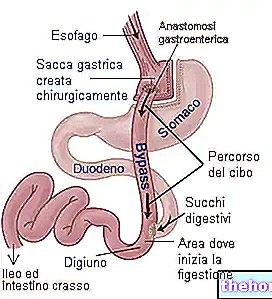
Weight loss is mainly due to the limited amount of food that can be ingested in a single meal (early satiety) and the increased time required to digest food. It is often performed by laparoscopy (LAGB) and represents a reversible intervention. : The gastric cavity is not dissected and the band can be removed Weight Loss: Approximately 50% of excess weight. - Roux-en-Y gastric bypass (RYGB): it is a mixed intervention, which limits both the intake and the absorption of food.
The amount of food that can be ingested is limited by reducing (by surgical resection) the stomach to a small pouch, similar in size to the pocket created with the gastric band. Furthermore, this small sac is connected, by means of a jejunal loop, directly to the small intestine (at the height of the jejunum), excluding the digestive tract responsible for the absorption of nutrients (part of the stomach, duodenum and biliary tract). RYGB is considered an irreversible intervention, but, in some cases, the procedure can be partially reversed. Weight loss: about 60-70% of excess weight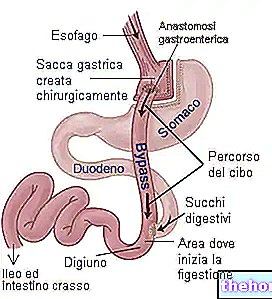
- Biliopancreatic diversion with duodenal switch (BPD-DS): usually referred to as "duodenal switch" (duodenal inversion), it is a complex bariatric surgery with three peculiarities:
1) eliminates a large portion of the stomach (vertical resection), making patients satisfied prematurely, who are "forced" to eat less; 2) it is a malabsorptive operation, where food is diverted and limited in its absorption: the surgeon creates a new alimentary canal, creating an "anastomosis between the residual gastric cavity and a section of the small intestine (ileum); 3) the functionality of bile, pancreatic juice and enteric juices is modified, affecting the body's ability to digest elements and absorb calories. This operation leaves a small part of the duodenum available, which is needed to absorb food, vitamins and minerals. However, when the patient ingests a meal, most of the bowel is bypassed (it is a more "drastic than the previous" surgery). The distance between the stomach and the colon becomes much shorter after this operation, thus limiting the normal how food is absorbed. BPD-DS produces significant weight loss (approximately 65-75% of excess weight). However, a decrease in the amount of nutrients, vitamins and minerals absorbed carries a high risk of long-term complications (anemia, osteoporosis, etc.) Therefore, bilopancreatic diversion is generally only recommended when rapid weight loss is believed to be essential to avoid a serious health condition, such as heart disease.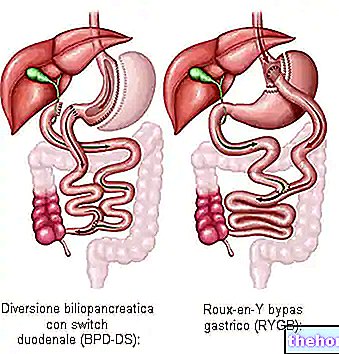
- Partial vertical gastrectomy (VSG, vertical sleeve gastrectomy): belongs to gastrorestrictive interventions, because it limits food intake by reducing the size of the stomach
This form of bariatric surgery is used to treat severely obese people (BMI ≥ 60), for whom a bandage or gastric bypass is not recommended. In such circumstances, both procedures would carry a risk. very high to cause complications. The goal of the procedure is to induce an early sense of satiety. To pursue this, a partial vertical resection is performed during the surgery that affects 80-90% of the stomach. Weight loss should be approximately 60% Once this has been achieved, it should be possible to perform a gastric bandage or bypass safely.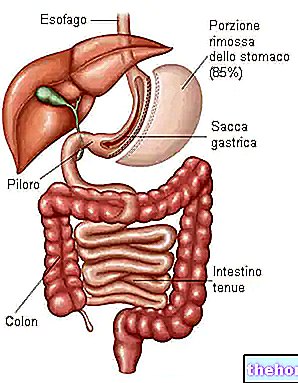
The patient and the competent surgeon must confront each other to choose the best surgical option, evaluating the long-term effects and any complications that may arise during and after surgery (such as problems related to malabsorption, vomiting and esophageal reflux. , the impossibility of consuming large meals, the need to limit especially certain foods, etc.). Other factors to consider are the patient's BMI, his eating habits, the repercussions of obesity on his health and any previous surgical interventions at the stomach.
Effectiveness
The purpose of bariatric surgery is to reduce the risk of disease or death associated with obesity. In general, malabsorptive procedures induce greater weight loss than restrictive procedures, however they have a higher risk profile.
Recovery after bariatric surgery
Immediately after bariatric surgery, the patient is limited to a liquid diet, which includes foods such as broth or diluted fruit juices. This line is adopted until the gastrointestinal tract is fully recovered from the operation. In the later stages, the patient is "forced" to take only modest quantities of food, since if he exceeds the containment capacity of the stomach he can experience nausea, headache, vomiting, diarrhea, dysphagia, etc. Dietary restrictions partly depend on the type of surgery. Many patients, for example, will need to take one multivitamin a day for life to compensate for the reduced absorption of essential nutrients.
Side effects
A variety of complications can be associated with bariatric surgery procedures. The risks depend on the type of surgery and any other health problems present prior to the operation. In the postoperative period, some short-term complications (within 1-6 weeks after surgery) may include bleeding, infection of surgical wounds, intestinal obstruction. , nausea and vomiting (due to overeating or stricture at the surgical site). Other problems that may occur are related to nutrient deficiencies, typical of subjects undergoing malabsorptive bariatric procedures who do not take vitamins and minerals; in extreme cases, if patients do not face the problem, diseases such as pellagra (caused by deficiencies of vitamin B3, niacin), pernicious anemia (deficiency of vitamin B12) and beriberi (caused by lack of vitamin B1 thiamine) can occur. After bariatric surgery, other major medical complications may include: venous thromboembolism (deep vein thrombosis in the legs and pulmonary embolism), heart attack, pneumonia, urinary tract infections, gastrointestinal ulcers, gastric and / or intestinal fistula, strictures and hernias (hernias and internal hernia).





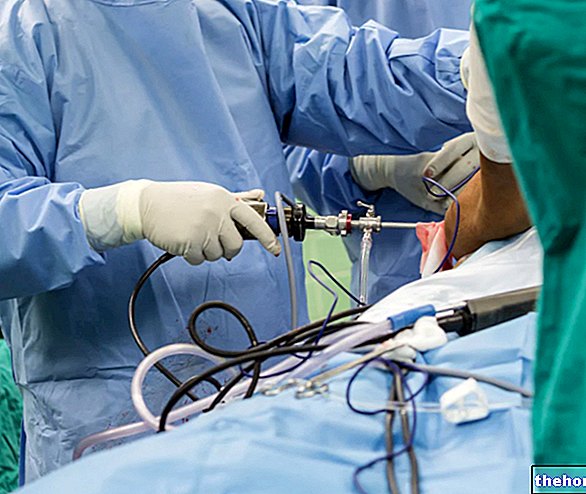

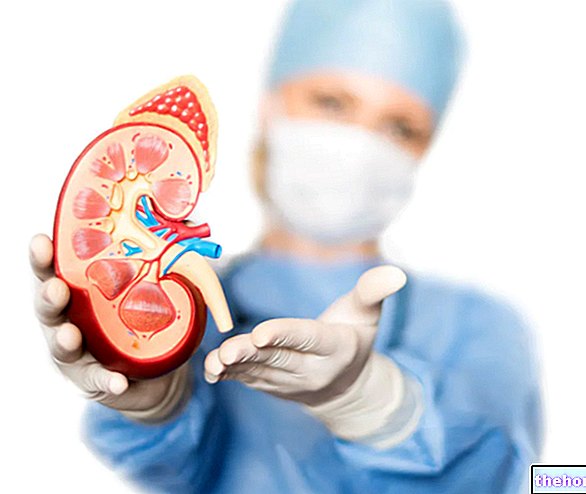

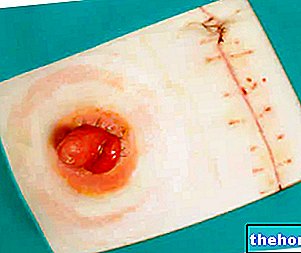
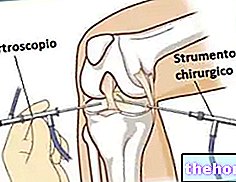









.jpg)











